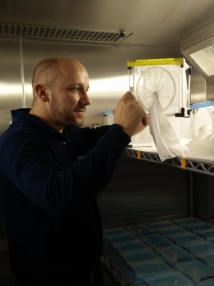Summary
I am a molecular biologist trying to manipulate the biology of the mosquitoes in ways that can interfere with their ability to transmit disease. I work mostly on the mosquito Anopheles gambiae, the main vector of the most severe form of human malaria in Africa. I am applying this work in the fields of genetic control, such as gene drive, and in understanding the genetics of insecticide resistance.
Since January 2019 I have taken up a position at group leader at the Liverpool School of Tropical Medicine but I will continue to hold an honorary appointment at Imperial to maintain some of my research and teaching interests there.
Selected Publications
Journal Articles
Bernardini F, Kriezis A, Galizi R, et al., 2019, Introgression of a synthetic sex ratio distortion system from Anopheles gambiae into Anopheles arabiensis, Scientific Reports, Vol:9, ISSN:2045-2322
Kyrou K, Hammond AM, Galizi R, et al., 2018, A CRISPR-Cas9 gene drive targeting doublesex causes complete population suppression in caged Anopheles gambiae mosquitoes, Nature Biotechnology, Vol:36, ISSN:1087-0156, Pages:1062-1066
Hammond AM, Kyrou K, Bruttini M, et al., 2017, The creation and selection of mutations resistant to a gene drive over multiple generations in the malaria mosquito, PLOS Genetics, Vol:13, ISSN:1553-7390
Bernardini F, Galizi R, Wunderlich M, et al., 2017, Cross-Species Y Chromosome Function Between Malaria Vectors of the Anopheles gambiae Species Complex., Genetics, ISSN:0016-6731
Hammond A, Kyrou K, Bruttini M, et al., 2017, The creation and selection of mutations resistant to a gene drive over multiple generations in the malaria mosquito, PLOS Genetics, ISSN:1553-7390
NOLAN T, CRISANTI A, 2017, Using gene drives to limit the spread of malaria, Scientist, Vol:31, ISSN:0890-3670
Beaghton A, Hammond A, Nolan T, et al., 2017, Requirements for Driving Antipathogen Effector Genes into Populations of Disease Vectors by Homing, Genetics, Vol:205, Pages:1587-1596
Nolan T, Crisanti A, 2016, DRIVING OUT MALARIA, Scientist, Vol:31, Pages:24-31
Hammond A, Galizi R, Kyrou K, et al., 2016, A CRISPR-Cas9 gene drive system-targeting female reproduction in the malaria mosquito vector Anopheles gambiae, Nature Biotechnology, Vol:34, ISSN:1087-0156, Pages:78-83
Castellano L, Rizzi E, Krell J, et al., 2015, The germline of the malaria mosquito produces abundant miRNAs, endo-siRNAs, piRNAs and 29-nt small RNAs, Bmc Genomics, Vol:16
Neafsey DE, Waterhouse RM, Abai MR, et al., 2015, Highly evolvable malaria vectors: The genomes of 16 Anopheles mosquitoes, Science, Vol:347
Volohonsky G, Terenzi O, Soichot J, et al., 2015, Tools for Anopheles gambiae Transgenesis, G3-genes Genomes Genetics, Vol:5, Pages:1151-1163
Fuchs S, Behrends V, Bundy JG, et al., 2014, Phenylalanine Metabolism Regulates Reproduction and Parasite Melanization in the Malaria Mosquito, Plos One, Vol:9
Fuchs S, Rende E, Crisanti A, et al., 2014, Disruption of aminergic signalling reveals novel compounds with distinct inhibitory effects on mosquito reproduction, locomotor function and survival, Scientific Reports, Vol:4
Fuchs S, Rende E, Crisanti A, et al., 2014, Disruption of aminergic signalling reveals novel compounds with distinct inhibitory effects on mosquito reproduction, locomotor function and survival., Scientific Reports, Vol:4, Pages:srep05526-srep05526
Catteruccia F, Nolan T, Loukeris TG, et al., 2000, Stable germline transformation of the malaria mosquito Anopheles stephensi, Nature, Vol:405, Pages:959-962

